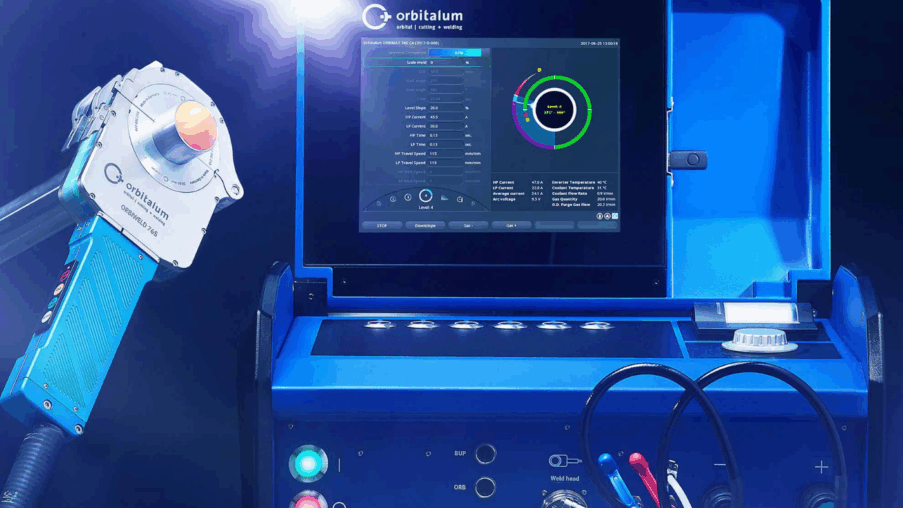Cleanrooms are highly controlled environments used in industries such as pharmaceuticals, biotechnology, semiconductor manufacturing, and aerospace. The integrity of a cleanroom lies in its ability to maintain extremely low levels of airborne particles and contaminants. To achieve this, the design, construction, and materials used in cleanrooms must meet strict standards. One crucial technology that plays a vital role in the construction of cleanrooms is orbital welding.
The Cleanroom Challenge
In cleanroom environments, the risk of contamination from equipment, personnel, and even construction materials is tightly controlled. Piping systems—particularly those that carry gases, chemicals, or ultrapure water—must be welded with extreme precision to avoid introducing contaminants. Any defects, such as cracks, crevices, or inclusions, in welds can harbor bacteria or particulates that compromise the cleanroom’s function.
Benefits of Orbital Welding in Cleanroom Construction
- Contamination Control Orbital welding produces smooth, consistent, and full-penetration welds that are virtually free of contaminants. This is essential in cleanroom applications, where even microscopic irregularities can become contamination sites. The closed weld heads used in orbital welding systems also help reduce the risk of environmental contamination during the welding process.
- High-Quality, Repeatable Welds Orbital welding systems are programmed with specific parameters such as travel speed, current, and electrode positioning. This automation ensures that every weld is uniform, reducing variability that can occur with manual welding. In cleanroom construction, consistency is key—especially in pharmaceutical or semiconductor applications where any deviation could lead to process failure.
- Compliance with Industry Standards Orbital welding helps meet stringent industry standards like ASME BPE (BioProcessing Equipment), which sets the benchmark for hygienic design and fabrication. These standards require smooth, crevice-free welds with complete penetration and minimal heat-affected zones—criteria orbital welding consistently achieves.
- Improved Efficiency and Productivity Because orbital welding is automated, it significantly reduces the time required for welding compared to manual methods. This increases productivity and helps meet tight project timelines common in cleanroom construction. The reduction in rework and inspection times further enhances overall efficiency.
- Minimal Human Error Automation reduces the potential for operator fatigue and human error. Once a program is established for a specific weld, it can be reused across multiple joints without variation. This is particularly beneficial in cleanroom construction, where skilled manual welders are in short supply and welding environments are restrictive due to cleanliness requirements.
- Safety and Ergonomics Cleanroom construction often involves working in confined spaces or awkward positions. Orbital welding systems allow operators to maintain a safer distance from the weld zone, minimizing exposure to heat, fumes, and ultraviolet radiation. This not only protects workers but also helps maintain cleanroom integrity by reducing the risk of introducing contaminants via human presence.
- Seamless Integration with Cleanroom Protocols Orbital welding systems can be operated in cleanroom conditions with minimal disruption to the controlled environment. Portable orbital welding systems with enclosed heads and purge capabilities allow welding to be performed without releasing particulates or gases that could compromise cleanroom standards.
Applications in Cleanroom Construction
- Stainless Steel Process Piping: Used for ultrapure water, gas delivery, and chemical transport.
- HVAC Systems: Especially in HEPA filter housings and ducting that require airtight welds.
- Pharmaceutical Bioreactors and Vessels: Where sanitary welds are essential to prevent microbial contamination.
- Semiconductor Manufacturing: Ultra-clean gas lines and vacuum systems rely heavily on orbital-welded joints to prevent contamination.
Conclusion
Orbital welding is not just a technological convenience—it is a necessity in the precision-driven world of cleanroom construction. By delivering contamination-free, high-integrity welds, it helps uphold the strict environmental standards required in cleanrooms. The result is safer, more reliable, and more efficient cleanroom facilities that support the advanced processes of modern industries.
As demand grows for cleaner and more controlled manufacturing environments, the role of orbital welding in cleanroom construction will continue to expand, driving innovation and excellence in high-purity fabrication.





